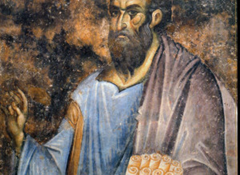 Former Catholic priest John Dominic Crossan is a co-founder and highly visible spokesman for the Jesus Seminar, a progressive group of New Testament scholars active in the last twenty years seeking to identify “the historical Jesus”.
Former Catholic priest John Dominic Crossan is a co-founder and highly visible spokesman for the Jesus Seminar, a progressive group of New Testament scholars active in the last twenty years seeking to identify “the historical Jesus”.
Recently, he has turned his attention to Paul the apostle. A few years ago, he co-authored, with Marcus Borg, an excellent book entitled The First Paul (2009), which I reviewed in three separate posts. Here’s a link to the three posts in reverse order. The central thesis of the book is that the thirteen New Testament books traditionally ascribed to the pen of Paul the apostle may be broken into three groupings: a) the radical and authentic Paul who was a social visionary vis a vis the existing culture—an opponent of slavery and proponent of a strong role for women, b) the conservative Paul, three books that may have been written by Paul but probably weren’t and which evinced a retreat from his radical social views, and c) the reactionary Paul, the so-called pastoral epistles consisting of 1st & 2nd Timothy and Titus, which were definitely not written by Paul and indeed were written to correct Paul’s radicalism, to re-establish the Roman social order of slavery and patriarchy.
Crossan is again writing about these themes in a highly public forum, the Huffington Post. His article is not only on the religious section of the Huffpost, but appears on the main page under the banner The Search for the Historical Paul: Which Letters Did He Really Write? As I write this, there are over 200 comments to Crossan’s Huffpost article, and like many public cyberspace forums, the “trolls” dominate. Many are anti-Christian, and a few are conservative Christians who insist, even if the human authorship is not Paul, that the subsequent letters were “spirit-breathed” and thus all letters are consistent and true (the holy trinity of inerrant, infallible, and inspired).
Crossan’s article is brief and seems not to plough new ground but merely restates the conclusions voiced earlier in the collaboration with Borg. Here is the central thesis of the Huffpost article:
The problem is that those post-Pauline or Pseudo-Pauline letters are primarily counter-Pauline and anti-Pauline. What happens across those three sets of letters is that the radical Paul of the authentic seven letters (Romans, 1-2 Corinthians, Galatians, Philippians, 1 Thessalonians, Philemon) is slowly but steadily morphed into the conservative Paul of the probably inauthentic threesome (Ephesians Colossians, 2 Thessalonians) and finally into the reactionary Paul of those certainly inauthentic ones (1-2 Timothy, Titus).
Crossan’s article includes this recently rediscovered and cleaned up fresco of Paul dating to the 13th century.  Note that Paul holds not one scroll and not thirteen scrolls but ten, signifying that the dubious authenticity of the pastoral epistles is not merely a recent understanding. Indeed, in 2nd century lists of authoritative books that served as precursors to the formalized New Testament canon, the pastoral epistles are generally not included.
Note that Paul holds not one scroll and not thirteen scrolls but ten, signifying that the dubious authenticity of the pastoral epistles is not merely a recent understanding. Indeed, in 2nd century lists of authoritative books that served as precursors to the formalized New Testament canon, the pastoral epistles are generally not included.
By the time The First Paul was published in 2009, my own manuscript for A Wretched Man, a novel of Paul the apostle was already completed and in the hands of the publisher. Thus, my research did not include The First Paul, but my conclusions were similar–but I had a special authorial problem. In a novel about the life of Paul, how could I suggest that six books traditionally attributed to him were not actually his? Written after his death, such books were not part of his story in a strict sense. Additionally, how could I make the point that he held radical views regarding slavery and women to rebut the traditional stereotype of Paul derived from the NT letters to Timothy and Titus?
My solution was two-fold. First, the novel included the circumstances and the writing and the delivery of the seven “authentic” letters. The six “inauthentic” letters were not mentioned at all, an implicit but indirect statement that they were not part of Paul’s story. Second, Timothy and Titus were important characters in the novel, protégés of Paul. In a purely fictional device, I placed offensive words about women quoted from the NT book of Timothy in the mouth of Timothy the character and offensive words about slavery from the NT book of Titus in the mouth of Titus the character. In both instances, the novel offers a strong rebuke from the lips of Paul.
